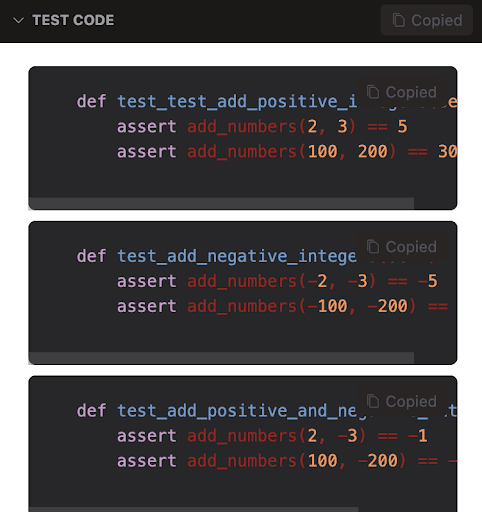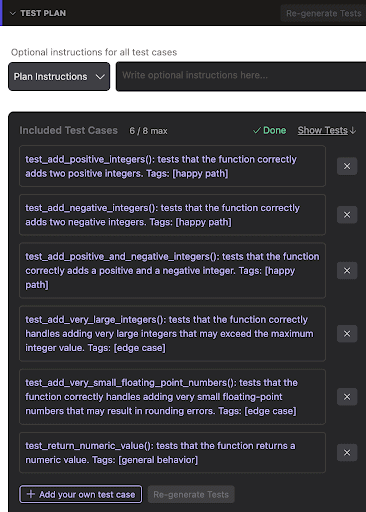
Unit Tests. That sounds exciting. Everyone knows the importance of tests and having good code test coverage, at least in theory.
But there is only one problem with it. Nobody likes to write unit tests. Typically, the importance of unit testing is discovered only when the fundamental flaws of the application are found and need serious refactoring.
This article will discuss the most modern practices for writing unit tests that your team could use. It might be surprising, but these days you can use automated unit test generation tools to help you achieve that goal.
Let’s start with the theory and then progress further to discuss how things could be done in a more efficient and modern way.
What is unit testing?
Unit testing is a software testing technique that involves breaking down a piece of code, typically a function or a method, into small and independent units and testing each unit individually. Unit testing aims to ensure that each unit of code works as intended and can be integrated into a larger system without issues.
The main idea behind unit testing is to isolate each unit of code and test it in isolation. This is achieved by replacing any external dependencies, such as a database or a network connection, with mock objects or stubs.
This way, the unit of code being tested depends only on itself and its immediate inputs, making it easier to test and debug.
The benefits of unit testing are numerous. Primarily, unit testing helps catch bugs early in the development process, making them easier and cheaper to fix.
By testing each unit of code in isolation, test engineers and developers can quickly pinpoint the root cause of any bugs and fix them before they propagate to other parts of the system.
Why perform unit testing?
There are multiple benefits of writing and executing unit tests:
- Early detection of defects: Unit testing helps to identify defects early in the development cycle when they are less expensive to fix.
- Improved code quality: Unit testing promotes the development of high-quality code by forcing developers to write testable and maintainable code.
- Faster development cycles: Unit testing reduces the time required for debugging and troubleshooting, allowing developers to focus on new features and functionality. Less QA time is necessary, too.
- Better collaboration: Unit testing helps developers to collaborate more effectively by providing a common language and a shared understanding of the software.
- Greater confidence in changes: Unit tests provide developers a safety net when making codebase changes, giving them the confidence to refactor and optimize without fear of breaking existing functionality.
Unit testing is an essential practice for any software development team looking to improve the quality and maintainability of their code while reducing the cost of development and maintenance over time.
What makes a good unit test?
The main point of writing unit tests is to improve your team’s software development efficiency. Here are some best practices for writing effective unit tests:
- Keep tests small and focused: A unit test should only test a single unit of functionality in isolation. Keep tests small and focused on making them easier to maintain and quickly identify the source of any issues.
- Write tests before code: Writing tests before writing code helps you to think about the desired functionality and to clarify requirements. This also makes it easier to write testable code.
- Use descriptive test names: Descriptive test names help to communicate the intent of the test and make it easier to understand the test’s purpose when reading the code.
- Use assertions to verify behavior: Use assertions to check that the output of the code matches the expected behavior. Make sure that your assertions check the right things to ensure the test is testing the functionality you intend.
- Use test fixtures to set up and tear down state: Use test fixtures to set up the state required for the test and clean up after the test. This ensures that each test runs in isolation and doesn’t interfere with other tests.
- Test edge cases: Be sure to test edge cases such as boundary conditions, empty or null inputs, and other less common scenarios that could still occur.
- Run tests regularly: Set up an automated test runner to run tests regularly as part of your continuous integration process. This helps to catch issues early on and ensure that changes don’t break existing functionality.
- Refactor tests with code changes: If you make changes to the code, make sure to refactor the tests as well to ensure they still test the intended functionality.
- Use code coverage tools: Use code coverage tools to ensure that your tests cover all the code that needs testing.
- Unit test automation: Last but not least, you can use specific tools to perform the unit test generation. You don’t need to write everything manually anymore. We will discuss using such tools in a moment.
By following these best practices, you can write effective unit tests that help to ensure that your code is robust and behaves as intended.
How to write a unit test manually?
We will discuss the Python example in this article.
Step 1: Set Up the Environment
Before diving into writing unit tests, we must set up our environment. For this, we will use Python’s built-in testing framework, unittest. Unittest is a testing framework that comes with Python and provides tools for writing and running tests. To use unittest, we need to import it into our Python script:
Step 2: Write the Test Cases
Once we have set up the environment, we can start writing our test cases. A test case is a unit of testing that verifies the functionality of a specific feature or behavior of the code. Test cases are typically organized into test suites, which are collections of related test cases.
Suppose we have a simple function that takes two arguments and returns their sum. Here’s how we can write a unit test for this function:
import unittest
def add_numbers(a, b):
return a + b
class TestAddNumbers(unittest.TestCase):
def test_add_numbers(self):
self.assertEqual(add_numbers(2, 3), 5)
self.assertEqual(add_numbers(0, 4), 4)
self.assertEqual(add_numbers(100, 200), 300)
In this example, we have defined a function called add_numbers that takes two arguments and returns their sum. We have also created a test case called TestAddNumbers that contains a single test method called test_add_numbers.
This method tests whether the add_numbers function returns the expected result for different input values. We have used the assertEqual method of the TestCase class to compare the actual output of the add_numbers function with the expected output.
The assertEqual method raises an AssertionError if the two values are not equal. In this case, if the add_numbers function returns the wrong result, the test case will fail.
Step 3: Write the Test Cases
Once we have written our test cases, we need to run them. We can do this by executing the following command in the terminal:
python -m unittest unit_test.py
While unit_test.py is the name of the Python file that contains our test cases, this command will run all the test cases defined in the file and report any failures or errors.
Step 4: Analyze the Results
After running the tests, we must analyze the results to determine whether our code works as expected. Unittest provides a report of the test results that we can use to identify any errors or failures. For example, the following is a sample report:
Ran 1 test in 0.000s
OK
This report indicates that our tests have passed.
How to automate unit testing?
Manually writing the unit tests can be repetitive and challenging, and you might miss important code paths. However, this task could be automated. We could use the power of AI tools such as qodo (formerly Codium) to write those tests for us.
This tool can help write automated unit tests using machine learning techniques to generate test cases covering a wide range of inputs, outputs, and edge cases.
Let’s follow the previous example of our add_numbers test. We need to install the qodo (formerly Codium) extension from Visual Studio Code Marketplace and write our sample function once again:
def add_numbers(x, y): return x + y
Once we do that, we will see the hint that the qodo (formerly Codium) plugin shows us. Click it to see the unit test generation magic.
Here are some ways qodo (formerly Codium) can assist in automated unit testing:
- Test case generation: qodo (formerly Codium) can automatically generate test cases for your code by analyzing its inputs, outputs, and logic. This can help you create more comprehensive test suites that cover a wider range of scenarios and edge cases.
- Code coverage analysis: qodo (formerly Codium) can analyze your code and identify parts not covered by your existing test cases. This can help you ensure that your tests are thorough and that you are not missing any critical functionality.
- Regression testing: qodo (formerly Codium) can help you identify areas of your code most likely to be affected by changes and generate new tests or update existing ones accordingly. This can help you catch bugs and regressions early in the development process.
Those are the example automated unit tests that qodo (formerly Codium) has provided for us:
def test_test_add_positive_integers(self):
assert add_numbers(2, 3) == 5
assert add_numbers(100, 200) == 300
def test_add_negative_integers(self):
assert add_numbers(-2, -3) == -5
assert add_numbers(-100, -200) == -300
def test_add_very_small_floating_point_numbers(self):
assert add_numbers(0.000001, 0.000002) == pytest.approx(0.000003)
assert add_numbers(0.1e-10, 0.2e-10) == pytest.approx(0.3e-10)
def test_return_numeric_value(self):
assert isinstance(add_numbers(2, 3), (int, float))
assert isinstance(add_numbers(-2, -3), (int, float))
assert isinstance(add_numbers(2, -3), (int, float))
As you can see, it expanded the unit test coverage and allowed us to enhance our coverage. We can use it to understand the scope of testing in more complex examples.
Can unit testing replace manual testing?
Unit testing can complement manual testing but cannot replace it entirely. Manual testing involves a tester executing a software application’s features and functionalities to identify defects, bugs, and usability issues. On the other hand, unit testing involves writing automated tests for individual units or components of the software to ensure they function as intended.
Unit testing can help reduce the number of defects found during manual testing by catching issues early in the development cycle. This can save time and money by allowing developers to fix issues before they become more challenging and costly to address.
However, unit testing cannot replace manual testing entirely because it cannot capture all the issues a manual tester might find. Manual testing can identify usability issues, performance problems, and other issues that might not be apparent through unit testing alone.
Therefore, unit and manual testing should be used in combination to achieve the best results. Unit testing can help ensure that individual units of code are functioning correctly, while manual testing can help ensure that the software as a whole is meeting the intended requirements and is usable for end-users.
Conclusion
We have discussed the benefits of unit testing and explored automatic unit test generation using the power of qodo (formerly Codium) and Python. We have seen how to write test cases using the unittest framework, how to run the tests, and how to analyze the results.
Implementing unit testing strategies early in the development process is important, ideally before any code is written. This can help catch issues early on and prevent them from snowballing into larger problems later.
By following these best practices, developers can create robust and reliable unit tests that help ensure the quality and stability of their code.











